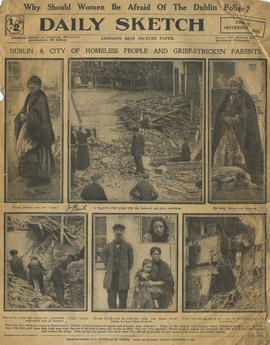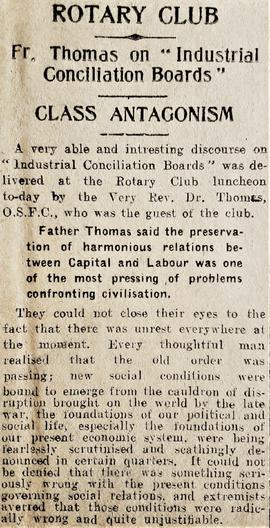Although the Capuchins arrived in Cork as early as 1637 it was many years before they took up residence on the site now known as Holy Trinity Church and Friary. The first Capuchin friars in Cork initially resided on the southern side of the city, just outside the South Gate. The religious upheavals of the seventeenth century occasioned many hardships for the friars who lived in constant fear of arrest and banishment. By the early eighteenth century the Capuchins appear to have established a permanent apostolate in the South Parish and by 1741 had built a small Friary on Blackamoor Lane situated just behind O’Sullivan’s Quay. In 1771 the community was augmented by the arrival from France of Fr. Arthur O’Leary OSFC (1729-1802). A native of West Cork, he joined the Capuchin Order on the continent and was ordained in St. Malo in 1758. O’Leary was responsible for the building of the small chapel on Blackamoor Lane which subsequently became known as the ‘South Friary’. During the first half of the nineteenth century Cork underwent a rapid expansion in both geographical size and population growth. It soon became apparent that the Friary on Blackamoor Lane was not sufficient to meet the demands of a growing congregation. By the mid-1820s, Fr. Theobald Mathew OSFC (1790-1856), Provincial Minister of the Irish Capuchins and guardian (local superior) of the Cork community, decided to build a larger church in a more convenient location. Rejecting a site on O’Sullivan’s Quay, a location on Charlotte Quay (now Father Mathew Quay) below Parliament Bridge was eventually acquired. This area was then a busy a trading and shipping centre with many provisioning merchants, artisans and traders having offices and stores on the quayside. As the city expanded, the emerging Catholic business class sought to assert its power in social and public life. This self-confidence was reflected in the grandiose, perpendicular Gothic design for the new Capuchin church which was submitted by the well-known Cork-based architect George Pain (1793-1838).
Work commenced on the church in October 1832 but almost immediately the project ran into difficulties. The marshy site selected for the building soon became waterlogged and an additional £1,600 was required for the purchase of steam pumps. Afterwards, a lawsuit was filed by George Pain for the payment of an additional £300. In addition, the builder Thomas Anthony, who claimed to have taken the contract at too low a figure, went out of business. The firm of Sir Thomas Deane (1792-1871) & Company completed the church (excepting the steeple) with Thomas Coakley acting as supervising architect following George Pain’s death in 1838. The interior of the church was completed by William Atkins (1811-1887). Theobald Mathew’s preoccupation with the nationwide temperance campaign, the onset of the Great Famine and a lack of financial resources were also contributory factors in delaying the completion of the church. Although the building opened for religious services on 10 October 1850, it remained without a tower and ornamental façade for many years. Money was subsequently collected by the local guardian, Fr. Louis (John) O’Connell OSFC, but the sum was not sufficient to finance the completion of the church. It was not until the centenary celebrations of Theobald Mathew’s birth (1890) that sufficient funds were raised to finish the construction of the building. The church was completed to the design of the local architect Dominick J. Coakley (d. 1914). Although Coakley reduced the size of the spire, the building is largely as George Pain originally designed it. By 1884 the Capuchin friars had also managed to build a Friary adjoining Holy Trinity Church, having previously resided in a house situated at the corner of Queen Street and Charlotte Quay. The Friary building was designed by Robert Walker (c.1835-1910).
In the following years further ornamentation and building work enhanced the church interior. A special bell, replacing one erected sixteen year earlier, was blessed after Mass on 26 April 1896. It was the gift of H. O’Donovan. A memorial to Fr. Bernard Jennings OSFC (1850-1904) in the form of an expansion to the church was undertaken by a special committee formed for that purpose in 1906. This expansion was built upon property which the community had acquired situated to the rear of Holy Trinity Church. Foundation trenches had to be sunk to a depth of twenty feet below street level before construction work could commence. The High Altar, over which a memorial window for Daniel O’Connell had been erected, and two adjoining side altars, were taken down and replaced in the new extension. Shortly after this work was completed the sanctuary was extended, eventually opening in April 1908. A memorial window by Harry Clarke (1889-1931), the renowned stained-glass artist, was erected in 1918 by Cork trade unionists in recognition of the services rendered by Fr. Thomas Dowling OSFC (1874-1951) in improving conditions for the city’s workers. In the late 1970s Fr. Eustace McSweeney OFM Cap., guardian, initiated plans to bring the interior of the church more into line with the liturgical requirements set down in the Second Vatican Council. It also became clear that the physical fabric of the building required extensive renovation work. A survey undertaken by Brian Wain & Associates, architects, discovered serious structural defects including dry rot infestation, damage caused by the ingress of water into roofing spaces and extensive corrosive damage to the steeple. As a result, a major project of reconstruction was begun in January 1982. This renovation work was largely completed within a year and the church was reopened for public worship in November 1982.
Collection Content
The collection consists of records relating to the Capuchin community in Cork city and in particular to the foundation known as Holy Trinity Church and Friary situated on Father Mathew Quay (formerly known as Charlotte Quay). The majority of the material dates from the mid-nineteenth century to the late twentieth century. The fonds includes legal records relating to the acquisition, transfer and disposal of church property (such as deeds of title, mortgages and bills of sale), financial records, and material relating to individual members of the Capuchin community in Cork. The collection includes a large number of administrative and community files, financial statements and books of account relating to building construction and structural alterations, correspondence, plans, publicity material, photographs, and miscellaneous items of ephemera connected with Capuchin ministries and apostolates in Cork. The collection also includes unpublished historical writings and biographical material relating to notable members of the Order who ministered in the city. The collection also includes records and registers relating to the Third Order of St. Francis (now the Secular Franciscan Order) and other sodalities and confraternities attached to Holy Trinity Church.


